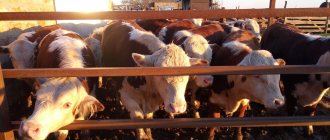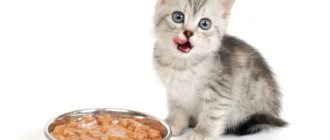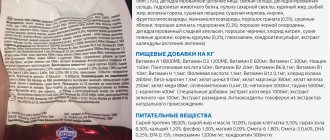The health of pigs, their growth and development, and the quality of pork directly determines the feeding of piglets from 1 to 6 months. From birth, little pigs require the maximum amount of nutrients that mother's milk contains. Yet it is often missing. How to feed a baby from the first day of his life, what products to use to form a balanced diet in the future are important issues for a successful pig farm.
Stages of feeding baby pigs
What little piglets eat during different periods of life directly depends on the ability of their digestive system to absorb food. The most important stages of feeding a pig offspring are the dairy and fattening periods, as well as the growing stage.
Milk feeding of piglets lasts up to a maximum of 2.5 months. On the other hand, sows often do not have enough milk to feed their offspring by the end of the first month. At this time, stronger individuals appear within one brood and win their priority right to food.
Then month-old babies are given feeding in small portions. It is also important how many times a day the piglets are fed. Considering their small stomachs, which are in the process of formation, it is better to make smaller portions, but give food to the cubs 6-7 times a day.
There are little pigs in rearing, which have gained weight of 20-25 kg and no longer feed on their mother's milk. Their body is completely ready to absorb dry food, root vegetables, greens and other foods that pigs love.
In general, what young animals eat depends on the goals of pig farmers. By this time, it is recommended to castrate wild boars that are raised for meat. When pigs are given a lot of feed, the main task, of course, is to obtain maximum weight gain. But the immediate diet is entirely determined by the specifics of the final product.
How many times a day should I feed?
It is recommended to give food to young animals at certain hours. It is advisable to follow expert advice regarding the frequency of feedings, which is presented below.
- Pregnant sows need to be fed once a day.
- Lactating sows are provided with two meals a day.
- Weanlings should eat 3 times a day.
- Fattening piglets require 3-4 feedings a day. It is recommended to pour roughage into the feeders a couple of times a day.
When feeding piglets, one of the nutritional regimens suggested below can be used.
- Constant access to food allows the young to eat to their heart's content. Feeders are cleaned every other day to avoid the accumulation of old food, which the animals push aside. The use of this system is advisable for feeding weaners and piglets aged 8-12 weeks.
- Rated, in which piglets are fed twice (occasionally three times) a day. The feed poured into the feeders should remain in the pigsty for no longer than 2 hours. This technology promotes rapid weight gain and reasonable feed consumption. However, using this method of feeding, it is important to systematically inspect the young animals, while assessing their behavior and well-being. It is advisable to use a standardized diet for fattening suckling sows and piglets that are being raised.
- Limited, in which a slightly smaller portion of the feed that the young animals could eat is poured into the feeders. The main part of the diet should consist of roughage. This method is only advisable when fattening animals to obtain lean meat.
What do piglets eat in the first month after birth?
The main goal of pig farming is to raise healthy, heavy animals in a short time with minimal costs. From the very beginning, it is important to have a clear idea of what to feed little piglets after they are born.
Pig milk contains all the nutrients a piglet needs. The only exception is iron, which must be administered additionally. On the other hand, the rapidly growing organism of newborn babies requires additional nutrition from the 5th day.
At this time, babies’ digestive system is developing, teeth are growing, so their body requires calcium, potassium, sodium, iron, which partially contain special mineral supplements. On the tenth day of animal life, it is recommended to add chopped carrots to the feed. Three weeks after birth, mother's milk in the pig's diet should be limited, increasingly using boiled potatoes and prepared hay.
We'll tell you what to feed one-month-old piglets and older ones below.
We start with charcoal
The milking period of piglets lasts on average 2 months. At this time, this product plays a key role.
You can use skim milk or whole milk. In this case, the first will require a total of 5-6 liters, and milk - about 8 liters for the entire period of time. The main thing is to give the product warm.
From the first days of a pig's life, it is recommended to add minerals to pig feeders in pens for young animals. This role can be perfectly fulfilled by charcoal, turf, pieces of chalk, and red clay. Only after the piglet learns to chew them and drink water, can you start feeding him with cereals prepared on a milk basis.
It is important to accustom young animals to a vegetable menu. First, the vegetables are given pureed, then cut into small cubes before adding to the feed. Next, mashed potatoes and beets are used to feed the babies, which are mixed with concentrates. After the first month of life of pigs, it is recommended to actively enrich their diet with green food. Mown grass needs to be partially processed, for example, we steam coarse greens. In this case, you should not use potato, tomato tops or poisonous plants.
What to feed pigs for rapid growth at home
Milk period
Piglets begin teething on the fifth to seventh day after birth, and roasted grains of wheat, corn, and peas can be added to their diet.
To prevent intestinal diseases, yogurt is suitable. Then extruded feed is added to the menu in the form of compound feed with impurities, only in small quantities. Upon reaching 10 days, piglets can be pampered with ground carrots (10-15 g per day), dust, and bean hay. From the third week, boiled potatoes, pumpkin and fodder beets are added. It is beneficial to feed pigs with feed yeast to increase their reproductive rate. By adding just 7% yeast to the mixture, it is possible to get the result in the form of an additional piglet for every 11 piglets in the litter. During lactation, sows also need feed yeast: this activates milk production, there is more of it, piglets eat faster, grow better and gain weight. In this case, it is possible to save on a milk substitute for newly born babies: the mother will be able to provide food for absolutely all her children.
Starting from 10 days of age, yeast is given to the piglets themselves, eventually increasing their content in the feed to 10%. Due to this, the rate of weight gain in animals increases, depending on the breed and other conditions, by 8-17%. The piglets grow strong and hardly get sick. The threat of metabolic problems is reduced to a minimum amount. The additive is administered at a rate of 10-15 g per day per piglet.
In the summer, young piglets can eat plenty of fresh grass and greens, which will have a beneficial effect on their growth. Animals accept various grasses, in addition to toxic ones and tops of potatoes and tomatoes; they especially like nettles and biting midge.
From the first weeks of their existence, piglets should have mineral supplements in the feeder: chalk, red clay, turf, charcoal. When the cubs learn to drink water and chew minerals, the diet can be supplemented with porridge cooked in milk and skim milk. In the first months after birth, piglets will need approximately 5-6 liters of skim milk and 6-8 liters of whole milk.
At one and a half months, piglets are separated from the sow and taught to independently eat dry and wet food. An integral part of the daily menu should be the presence of fish and meat and bone meal, low-fat milk, and vitamin and mineral supplements. Over time, piglets are accustomed to mixed feed.
In the second month of life, there is no need to feed piglets with buckwheat, corn, flax, wheat, rye, barley bran, since the proportion of meat decreases and the proportion of fat increases. As for oats, soybeans, cake, a large amount of them can be a factor in the sudden cessation of growth, as well as the yellowness of the fat and the looseness of the meat.
At 2 months of age, a pig must eat approximately 150 g of grain, 250 g of root vegetables, 600 g of skim milk, 500 g of potato and boiled potatoes, 100 g of grass flour, 15 g of chalk and 10 g of salt per day. If you follow all the nutritional rules, he will receive the required amount of necessary substances, and by the end of the dairy period, the weight of the young animal will be about 25 kilograms.
Technology, feeding standards for suckling piglets
As mentioned above, until the age of one month, complementary foods are provided to pigs in small doses up to 6 times a day, since the animals’ stomach is just forming. Start with mineral supplements and drinking water. At the age of 1 month, you can give raw grated carrots in the amount of 10-15 g per day.
Now let's look at what and how to feed pigs up to two months of age. Feeding standards for piglets on pig farms in % ratio are as follows:
- barley is the basis of feeding and accounts for 31%;
- component necessary for a growing organism: fish meal – 20%;
- oats occupy 11% of the diet;
- biological green feed and crushed wheat grain – 9% each;
- soybean meal – 7%;
- corn and skim milk in various forms – 6% each;
- essential mineral supplements and salt make up 1%.
At the age of one and a half months, little pigs begin to be gradually separated from their mother. From this time on, they are transferred to dry or wet food, excluding steamed grain from the diet. In the conditions of industrial pig farming, piglets in the second month of life must be additionally given low-fat milk, bone and fish meal, feed mineral additives and vitamins.
Pork diet for young animals aged from 2 to 2.5 months
At 2 months, young pigs are given about 0.6 liters of skim milk per head per day, 0.5 kg of potatoes, 0.25 kg of various root vegetables, 0.15 kg of crushed grain mixtures, 0.1 kg of grass flour, 0.015 kg of chalk and 0.010 kg salt. Based on the experience of successful owners and taking into account what the best pig breeders feed piglets, by the end of the dairy period of life you can get 25 kg of live weight from each individual. In the article “On feeding piglets at home” you will find additional information.
Animals must be fed according to certain rules to obtain a specific result. In order for the lard to be dense, soft and grainy, and for the quality of meat after slaughter to attract the most picky gourmets, it is necessary to adhere to certain restrictions. It is better to give 2-month-old piglets food with a small content of cereal components.
On pig farms in the warm season, feed mixtures need to be enriched with greens. It is recommended to mix boiled mashed potatoes with herbs. Piglets love this type of mash very much. Cake, hay shavings, that is, what babies eat to quickly gain weight, must be steamed before adding to feed.
To enhance the taste of dishes and activate their absorption by the pig's body, grain shit is good. Biological feed, yeast stimulates the growth of piglets. In total, an animal of this age should eat about 6 kg per day.
Special diet
As a rule, small piglets should be fed only sow's milk for the first two weeks. But this is only possible if there are few of them and the pig has enough milk. In other cases, starting from the 7-8th day of life, maternal nutrition is no longer enough for all babies. They grow quickly and gain weight, so they are always trying to steal something from the trough of adult pigs. Around this age you need to start feeding babies.
In the first month, the weight of piglets increases almost 5 times. But without proper feeding, such a result is difficult to achieve. Since they have a small stomach, they need to be fed often, but in small portions. Until about three weeks, their diet consists of 8 meals. It is very important to accustom animals to a variety of foods, but this should be done gradually.
Milk period
The milk period in pigs lasts up to 2-2.5 months. Proper diet at this time is very important for growth. Milk is the ideal food. You can give it either whole or skimmed, but always warm. During the first months of life, babies need about 6-8 liters of whole milk and 5-6 liters of skim milk.
From the first weeks, the trough should contain mineral supplements in the form of red clay, turf or charcoal. As soon as the kids learn to drink water and eat mineral supplements, they can include milk porridges, as well as reverse porridges. As for vegetables, they can be gradually introduced into the pigs’ diet, first grated and later cut into cubes. Potatoes are best boiled and served with concentrates in the form of puree.
From 10-15 days of age, piglets can be fed 10-15 grams of grated carrots per day. In the summer, from the first week you can give plenty of greens and grass. It makes babies grow quickly and gain weight. From the third week, boiled potatoes are introduced. If everything is done correctly, then by the end of the milk period the animal’s weight should average 25 kilograms.
Keep the trough for piglets clean, as they are very sensitive to diseases of the intestinal tract. To avoid frustration, all uneaten food should be thrown away, and the dishes should be thoroughly washed and treated with boiling water.
Growing up
This period covers the period of time from 2.5-3 to 4 months. As a rule, rearing is the basis for successful fattening of pigs. During this period, the most favorable conditions are created for rapid growth, and the animals gain weight due to an increase in muscle mass.
Now, in order for the pig to grow better, it needs to be fed with thick porridge: pea, barley, oatmeal. You can flavor it with bran, skim milk or whey, kitchen waste and all kinds of cleaning products. From succulent feed, piglets eat grass and garden tops, carrots, and potatoes. The animal should receive 15-20 grams of salt and chalk per day. In winter, growing allows feeding in the form of silage, hay dust and chaff, and root crops in double quantities.
After growing, the period of fattening of domestic pigs begins. In about two to three months, the gilt should increase its weight from 50-60 kilograms to 100-110 kg.
In order for piglets to grow quickly, starting from 3 months they need to be given concentrated feed.
Stern
As pigs grow, remember that the best way to achieve good weight is to feed them ad libitum. This means that you need as much food as the animal can eat at one time. But it is important to remember not only the quantity of food, but also its quality. Not all foods can be fed equally. Some require special training.
For example, in the first days hay should be chopped and given steamed, green grass should be given fresh in small portions. If it is possible to graze piglets, then at the very beginning they should be released into the meadow for no more than 1 hour. On other days, walking can be increased gradually, up to 6-8 hours a day.
Carrots need to be thoroughly washed, grated or cut into small pieces. At first, it is advisable to peel and cook potatoes. Starting from the growing period, you can cook the whole potato with the peel and even boil the potato peelings separately. It is better to mix potatoes with pea flour, bran, and chaff.
How to drink?
For good weight and growth, piglets should receive plenty of fresh, clean water. To do this, water at a temperature of at least 15 degrees is poured daily into a special trough with slats. If animals are frolicking and debris gets into the water, it must be replaced promptly and the container must be thoroughly washed. To prevent anemia, it is advisable to add copper sulfate to the swill at the rate of 1 gram per 1 liter of water.
How to properly feed piglets during growing
The life stage of piglets from 2.5 to 4 months is characterized by a complete rejection of mother's milk and rapid development of the pig's body.
On small and large pig farms, crushed concentrated feed is mixed with green mass, various root vegetables, melons, juicy vegetables and fruits.
Combined feed, which contains all the necessary vitamins and microelements, requires 1050 g per day for a three-month-old pig, and 1550 g for a four-month-old pig. At the same time, it is important to clearly understand whether certain products can be given to pigs without heat treatment, whether they will be beneficial or harmful to the animal’s body.
Some green grass, beet tops, cabbage leaves, sugar beets, and carrots are given raw. The coarse plant mass is fed to the steamed pigs. Feeding raw potatoes to piglets is strictly unacceptable, since their body is not able to digest such food. It is best to mix crushed boiled potatoes with herbs. Boiled red beets, concentrated mixtures, and salt are added to this liquid mash.
The rapid growth of animals is facilitated by feeding thick porridges based on barley, peas, and wheat with a meat component. Young animals need to be fed three times a day at regular intervals.
Features of feeding Vietnamese piglets
Vietnamese piglets need dosed nutrition. In the summer, the feeders are filled 2 times a day; in the cold season, the frequency of feeding increases to 3 times. The Vietnamese diet should be based on:
- squirrel;
- fat;
- fiber.
Piglets weighing between 28-55 kg should receive 250-300 g of feed daily. However, it is important to pay attention to the appearance of the pigs. The presence of a plump tummy, large cheeks and appetizing folds on the body indicates proper nutrition.
In this case, the farmer can easily feel the animal’s ribs. If such an action is difficult, then the piglets develop obesity, shortening their life span. In this case, it is necessary to reduce the feed dosage. If the ribs are clearly visible, this indicates underfeeding. It is important to take action as soon as possible.
The daily menu of a Vietnamese pig should contain a sufficient amount of:
- barley;
- wheat;
- rye;
- boiled eggs and dairy products;
- vitamins;
- Selena.
The grains are crushed and boiled until a thick paste forms. Such nutrition promotes rapid weight gain and strengthens the immunity of the Vietnamese. It is important to consider that the stomach of Vietnamese piglets is not able to fully digest grains in their raw form. There should always be clean and fresh water in animal drinking bowls. In the first 4 weeks after birth, piglets are given exclusively boiled water. It is unacceptable to use food waste in feeding the Vietnamese.
If you take into account the recommendations of experienced farmers, pig farming can become a profitable business. The correct combination of products will have a positive effect on the speed of animal weight gain and the taste characteristics of meat.
Farmer's tips for feeding piglets:
The most important components for fattening young pigs
When the piglet reaches a weight of 50 kg, you can begin fattening it. Fast growing pigs require more nutritious, concentrated feed. You can effectively feed young animals in 90 days. A diet consisting of various cereals, meat, fish and bone meal, root vegetables, vegetables, melons, fruits, minerals, and vitamin supplements will be the basis for successful cultivation.
The daily norm for one piglet as it grows becomes about two buckets (10 l) of feed mixtures. This will ensure a daily gain of 700 g.
A balanced diet should include proteins, fats, carbohydrates, important minerals and vitamins. Proteins are most abundant in meat, legumes, cereals, and milk. There are few of these substances in green feed and root crops. What is useful in them is carbohydrates, which are a source of energy for the growing pig’s body.
Fresh plants, vegetables, fruits are filled with vitamins and minerals. If the possibility of adding them to feed is small, then premixes are used, due to which the absorption of concentrated feed is increased. To activate metabolic processes, special feed additives are often used; this is often done on large pig farms.
In addition, the daily need for drinking water per head during fattening is 6-8 liters. Thus, this balanced menu is necessary for successful fattening of piglets.
Feeding options for piglets
A fairly large number of owners of such animals claim that the pig eats everything it can, especially when it comes to food that is in the house. However, it is worth noting that there is a difference between feeding a few piglets and feeding dozens of piglets. Therefore, the approach to diet between these two parties will be different. At the present stage, it has been proven that the combination of home and industrial feed additives leads to effective and productive results. We can say that you can’t get an excellent and big pig from waste alone.
Home conditions allow the owner to produce various animal feeds. You need to know that their stomach consists of one chamber, so it is difficult for pigs to process roughage. Today there are 2 types of feeding:
- Dry – consists of a grain diet with various additives;
- Wet - makes it possible to use a huge number of food vessels. In this case, the menu consists of various mash and food scraps.
Dry food
If you are a supporter of the position that animals are not waste places for food, then dry food is an ideal option. This food is not very varied, however, practice shows that this option perfectly increases the size of artiodactyl animals.
Also, another plus is that the feed does not create all sorts of reactions in the intestines, resulting in manure that can be used as fertilizer. If you don’t want to make your own food, you can buy a commercial one. It is useful because it already contains the necessary minerals and vitamins. At home, you need to add premixes and various additives to it.
Biofeed
This group includes many biofeeds.
First of all, these include greens, which are necessary for all artiodactyls.
It doesn’t matter whether the animal will be in nature on its own or you will give it a ready-made mixture. Products grown in the garden are also excellent as vitamins.
Various types and technologies of feeding piglets
The basis of feeding piglets is milk, grains, vegetables, and green feed. Depending on the breed of animals, industrial technologies for fattening them differ. The purpose of raising pigs may be to produce juicy, tasty meat. On the other hand, the result of feeding is often tender pork with a layer of fat. Fat fattening technology is based on various nutritious grain mixtures and root vegetables, which are the basis of most feeds.
To obtain high-quality meat with a thin layer of fat over the spine, a specific feeding method must be followed, which determines what piglets eat between 3 and 8 months of age. The menu should include a significant protein component. In this case, the diet is planned in such a way that the young animals gain 500-600 g of live weight every day.
Baby pigs are fed prepared silage, boiled potatoes, and meat waste. It is recommended to enrich the prepared grain mixtures with beetroot. You can brew herbs (for example, yarrow) and add decoctions for diluting feed. To enrich diets with amino acids during meat fattening, meat and bone, fish, and meat meal are used. From 50 to 300 g of such additives are required per head per day. Fishmeal is a source of complete proteins. To increase the average daily weight gain, feed yeast is added to the feed in an amount of 200-250 g.
Dangerous and harmful products for piglets
When raising young pigs, it is important to pay attention to the quality of feed. When the first signs of mold, mildew or rot appear, the products must be immediately removed from the pig diet and disposed of. If this is not done, then there is a high probability of poisoning and the development of infectious diseases.
Some plants are strictly forbidden to be used for feeding piglets. These include milkweed, dog parsley, horse dill, ranunculus, and hemlock. Castor bean and cotton cakes must be subjected to thermal or chemical treatment.
Improperly prepared foods are also dangerous for young pigs. For example, beets left in hot water for a long time after cooking can cause poisoning to small pigs. The water in which potatoes were boiled is also dangerous for animals. Sprouted potatoes must be thoroughly cleaned of sprouts before cooking.
Under no circumstances should piglets be fed green potato tubers, bananas, or citrus fruits. In addition, tea leaves left over from brewing and coffee grounds should not be added to the food. This can kill the animals.
Are you wondering what piglets are fed? If the article interested you and answered some important questions, please like it.
Leave your comments and share interesting facts via the Internet.










